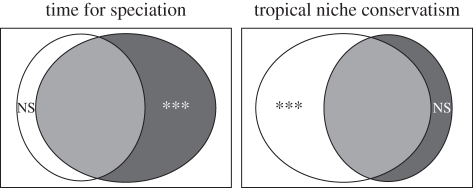Figure 1.
Conceptual distinction between two competing historical explanations of diversity gradients based on variation accounted for by environmental and spatial variables. In both cases, the rectangle represents the total amount of variation in phylogenetic characteristics of taxa. White circles represent variation accounted for by environmental characteristics, whereas black circles represent variation accounted for by spatial characteristics. Portion of white circle not overlapping with black circle represents unique environmental variation not related to spatial characteristics. Portion of black circle not overlapping with white circle represents unique spatial variation not related to the environment. Area of overlap represents shared variation explained by both suites of variables. The TFS hypothesis is a purely spatial mechanism and proceeds by a diffusive process. Thus, there should only be spatial signature to diversification. Nonetheless, because environmental characteristics inherently form gradients, variation in species richness and phylogenetic characteristics will be related to the environment to some degree and both environmental characteristics and spatial characteristics account for variation. Because this is a purely spatial process, spatial characteristics will account for more variation than environmental characteristics. Moreover, variation accounted for by environment will be only that correlated with spatial characteristics. Spatial characteristics will uniquely account for significant variation, whereas environmental characteristics will not. In contrast, the TNC hypothesis is a purely environmental mechanism that proceeds by evolution of species ecological niches. Thus, variation in phylogenetic characteristics should be most related to environmental characteristics. Nonetheless, again because environmental characteristics inherently form gradients, variation in phylogenetic characteristics will be related to spatial characteristics to some degree. Because this is a purely environmental process, environmental characteristics will account for more variation than spatial characteristics. Moreover, that variation accounted for by spatial characteristics will be only that correlated with environment. Environmental characteristics will uniquely account for significant variation in phylogenetic characteristics, whereas spatial characteristics will not.

